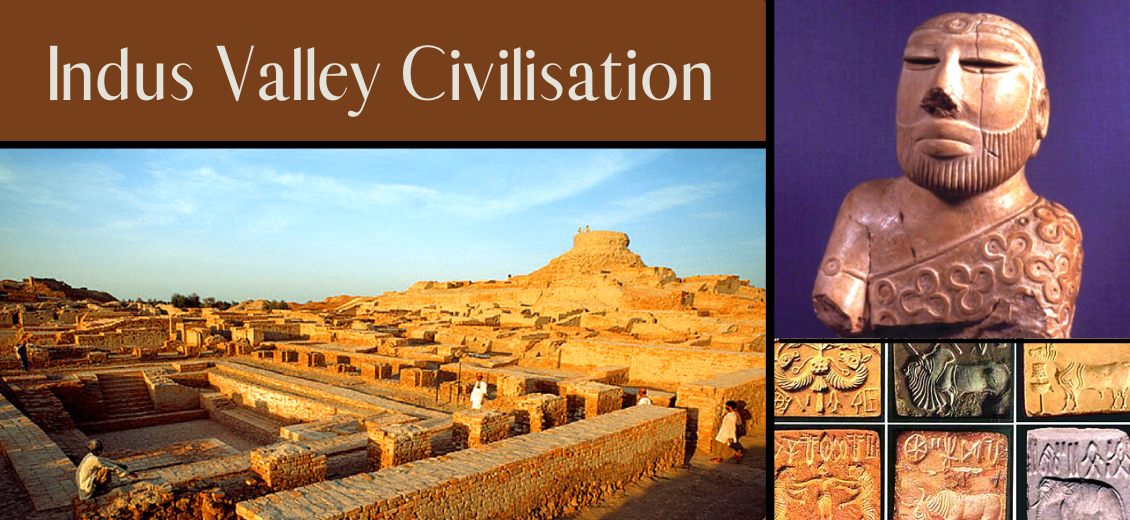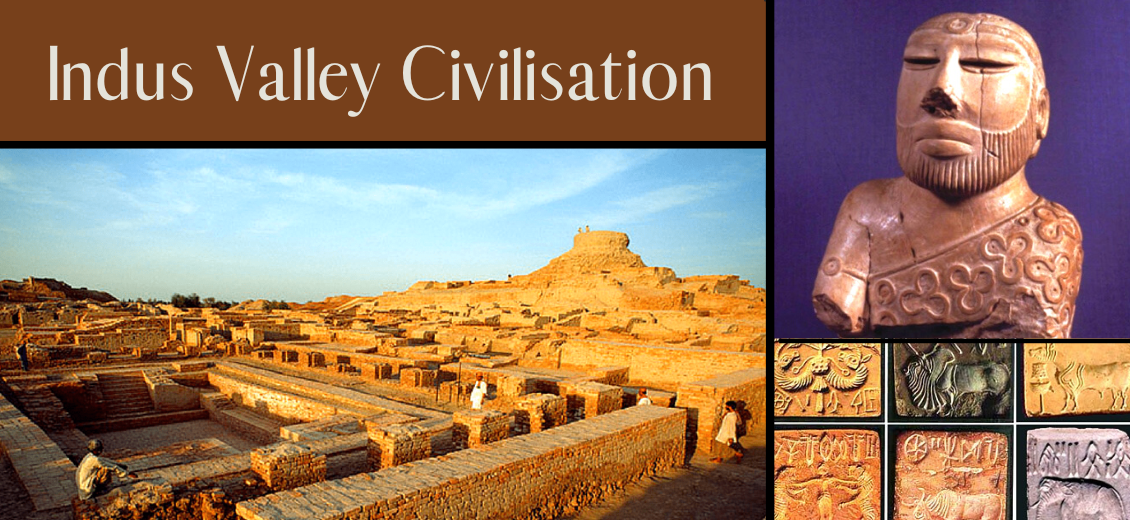
01 Jan 1970
Indus Valley Civilization history GK Quiz Test is useful for those students who are preparing for all Government and competitive exams like SSC CGL, CHSL, CPO, Steno, Banking Exams (SBI PO, IBPS SO, RRB Grade D, LIC AAO), UPSC Civil Service Exams.

25 QUIZ About INDUS VALLEY CIVILIZATION Part 1
Indus Valley Civilization
Indus Valley Civilization history GK Quiz Test is useful for those students who are preparing for all Government and competitive exams like SSC CGL, CHSL, CPO, Steno, Banking Exams (SBI PO, IBPS SO, RRB Grade D, LIC AAO), UPSC Civil Service Exam, CDS, Police, Railway, AAI, NDA, Post Office Exams, BPSC, ACEE, AIEED, APPSC, MPPSC, GPSC, OPPSC, UPPSC, UPSSSC and All-State Selection Commission Exams, and all other one day competitive exams also.
In this set we included important previous year questions also, so start todays test and boost your preparation with Sv Study Alert.
1. Question: What was the primary occupation of the people of the Indus Valley Civilization?
A) Agriculture
B) Fishing
C) Trading
D) Hunting
Solution: A) Agriculture
Explanation: The people of the Indus Valley Civilization were primarily engaged in agriculture. Archaeological evidence suggests advanced agricultural practices, including the use of a sophisticated irrigation system.
2. Question: Which of the following was a major city of the Indus Valley Civilization?
A) Harappa
B) Athens
C) Rome
D) Cairo
Solution: A) Harappa
Explanation: Harappa was one of the major cities of the Indus Valley Civilization. Along with Mohenjo-daro, it was a center of advanced urban planning and civilization during that period.
3. Question: What is the script of the Indus Valley Civilization called?
A) Cuneiform
B) Sanskrit
C) Pictographic
D) Brahmi
Solution: C) Pictographic
Explanation: The script of the Indus Valley Civilization is often referred to as pictographic. Despite extensive archaeological findings, the script has not been deciphered yet.
4. Question: Which river was most central to the geography of the Indus Valley Civilization?
A) Nile
B) Tigris
C) Indus
D) Yellow
Solution: C) Indus
Explanation: The Indus River was central to the geography of the Indus Valley Civilization. It provided fertile land for agriculture and played a crucial role in the development of the civilization.
5. Question: What is the most famous artifact associated with the Indus Valley Civilization?
A) Rosetta Stone
B) Terracotta Army
C) Great Bath
D) Sphinx
Solution: C) Great Bath
Explanation: The Great Bath is one of the most famous artifacts associated with the Indus Valley Civilization. It is a large, well-built structure found in the archaeological remains of Mohenjo-daro and is believed to have had ritual significance.
6. Question: What is the modern-day location of the ancient Indus Valley Civilization?
A) Pakistan and India
B) China and Mongolia
C) Iran and Iraq
D) Afghanistan and Tajikistan
Solution: A) Pakistan and India
Explanation: The majority of the ancient Indus Valley Civilization is located in present-day Pakistan and India, along the basin of the Indus River and its tributaries.
7. Question: Which of the following animals was not commonly depicted in the art of the Indus Valley Civilization?
A) Elephant
B) Bull
C) Tiger
D) Horse
Solution: D) Horse
Explanation: While the bull, elephant, and tiger were commonly depicted in Indus Valley art, there is limited evidence of horse representations. Horses became more prominent in later cultures.
8. Question: What was the purpose of the citadel in the major Indus Valley cities?
A) Religious ceremonies
B) Residential area for elites
C) Marketplace
D) Military defense
Solution: B) Residential area for elites
Explanation: The citadel in major Indus Valley cities is believed to have served as a residential area for elites or rulers. It often contained large structures, including possibly the residences of the ruling class.
9. Question: Which metal was not extensively used by the people of the Indus Valley Civilization?
A) Gold
B) Copper
C) Bronze
D) Iron
Solution: D) Iron
Explanation: Iron was not extensively used during the Indus Valley Civilization. Copper and bronze were more commonly utilized for tools and artifacts.
10. Question: What is the distinctive feature of the urban planning layout of the major Indus Valley cities?
A) Circular layout
B) Grid-like pattern
C) Radial pattern
D) Irregular arrangement
Solution: B) Grid-like pattern
Explanation: The major Indus Valley cities, such as Mohenjo-daro and Harappa, were characterized by a grid-like street layout, with streets and houses arranged in a planned manner.
11. Question: What is the purpose of the "Great Granary" found in the Indus Valley city of Mohenjo-daro?
A) Religious ceremonies
B) Residential purposes
C) Storage of grains
D) Administrative functions
Solution: C) Storage of grains
Explanation: The "Great Granary" in Mohenjo-daro is believed to have been used for the storage of grains, indicating advanced urban planning and management of resources.
12. Question: Which of the following is not a major Indus Valley site?
A) Harappa
B) Lothal
C) Taxila
D) Mohenjo-daro
Solution: C) Taxila
Explanation: Taxila is not a major site of the Indus Valley Civilization. It is an ancient city located in present-day Pakistan but is associated with later periods and different cultures.
13. Question: What type of seals were commonly used by the people of the Indus Valley Civilization?
A) Clay seals
B) Stone seals
C) Metal seals
D) Wooden seals
Solution: A) Clay seals
Explanation: Clay seals were commonly used by the people of the Indus Valley Civilization. These seals often contained inscriptions in the undeciphered script.
14. Question: What evidence suggests that the Indus Valley Civilization had a system of weights and measures?
A) Standardized bricks
B) Terra-cotta figurines
C) Beads and jewelry
D) Steatite seals
Solution: D) Steatite seals
Explanation: Steatite seals found in the Indus Valley often display marked divisions, suggesting a system of weights and measures used for trade and economic activities.
15. Question: What material was commonly used for the construction of houses in the Indus Valley Civilization?
A) Wood
B) Stone
C) Mud bricks
D) Marble
Solution: C) Mud bricks
Explanation: Mud bricks were a common construction material in the Indus Valley Civilization. The availability of mud in the region made it a practical choice for building structures.
16. Question: What is the likely reason behind the decline of the Indus Valley Civilization?
A) Invasion by foreign forces
B) Natural disasters
C) Environmental changes
D) Economic collapse
Solution: C) Environmental changes
Explanation: The decline of the Indus Valley Civilization is often attributed to environmental changes, such as the shift in the course of the rivers and changes in climate, leading to ecological challenges.
Quiz Area
Also, below are a few links that may help you score more in the upcoming Government exams: Free Mock Test Series with Solutions Previous Year Government Exams Question Papers PDF with Solutions Daily Current Affairs Free Job Alert ढूंढ रहे हैं सरकारी नौकरी या लेना है कॉलेज में एडमिशन, शिक्षा से लेकर जॉबअलर्ट तक हर लेखा जोखा है SV Study Alert के पास। जॉब अपडेट्स के लिए आज ही फॉलो करें हमारा व्हाट्सअप चैनल - यहां क्लिक करें Are You Looking For A Government Job Or Want To Take Admission In College?, SV Study Alert Has Every Detail From Education To Job Alert. Follow Our Whatsapp Channel Today For Job Updates - Click Here Now NOTE- Svstudyalert.com द्वारा सभी स्टडी मटेरियल हिंदी और अंग्रेजी दोनों भाषाओं में उपलब्ध कराया जाता है ऊपर दिए गए बटन “Choose Your Language” पर क्लिक करके आप सभी स्टडी मैटेरियल हिंदी / अंग्रेजी किसी भी माध्यम में प्राप्त कर सकते हैं |